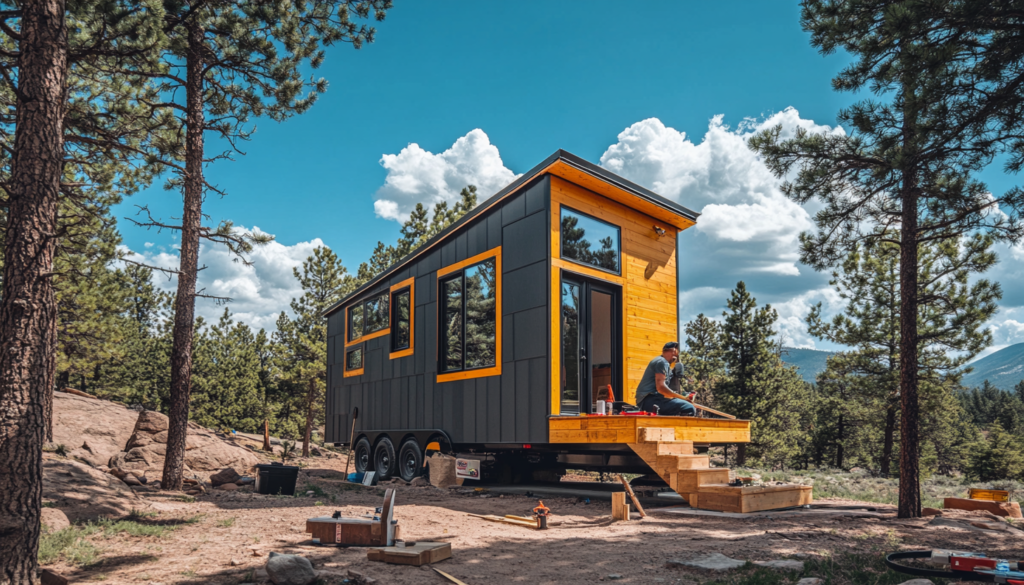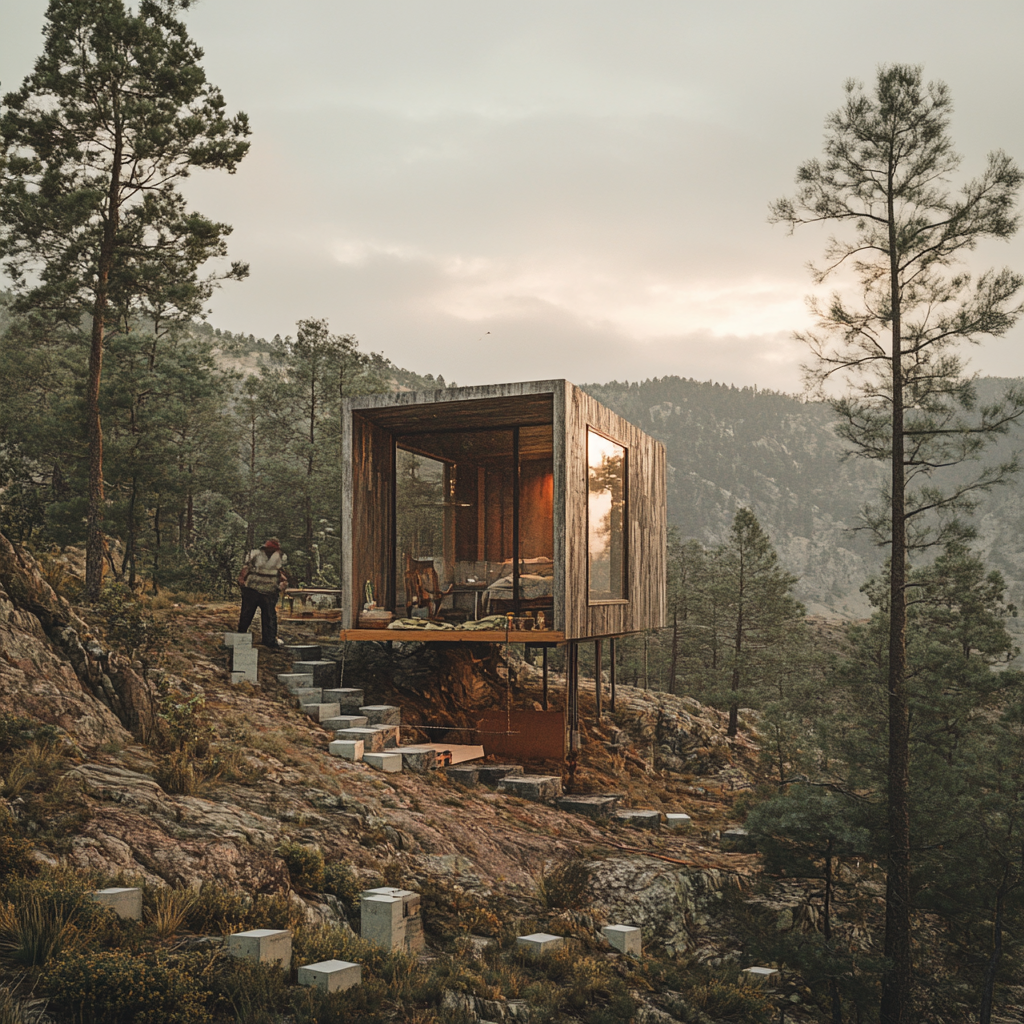Leveling your tiny house is key to its safety and comfort. This guide will show you how to make your tiny home stable, no matter the ground or base. You'll learn why leveling is important and how to do it right. By the end, you'll be ready to make your tiny house a cozy place …
Leveling your tiny house is key to its safety and comfort. This guide will show you how to make your tiny home stable, no matter the ground or base. You’ll learn why leveling is important and how to do it right. By the end, you’ll be ready to make your tiny house a cozy place to live for many years.

Key Takeaways
- Leveling your tiny house is essential for structural integrity and safety.
- Achieving a level tiny home enhances comfort and livability.
- Understand the different leveling methods, including permanent and temporary solutions.
- Learn how to prepare your tiny house and gather the necessary tools for leveling.
- Discover expert tips for leveling a tiny house on a trailer or foundation.
The Importance of Leveling Your Tiny House
Leveling your tiny house is key to keeping it safe and strong. It makes sure the home sits right, avoiding uneven floors and doors. This makes your tiny house more comfortable and helps it last longer.
Structural Integrity and Safety Considerations
Not leveling your tiny house can cause big problems. Doors and windows might not work right, and walls could lean. These issues are dangerous and can weaken your tiny house over time.
Enhancing Comfort and Livability
A level tiny house looks good and feels better to live in. Sloping floors can make things move around, making it hard to keep things tidy. Leveling your house makes it safer and more fun to live in.
| Benefit | Description |
|---|---|
| Structural Stability | Leveling ensures the tiny house’s frame and foundations remain sturdy and secure, preventing damage over time. |
| Safety | A level tiny house reduces the risk of tripping hazards, binding doors and windows, and other safety concerns. |
| Comfort | Leveling creates a smooth, even surface that enhances the overall livability and enjoyment of the tiny house. |
Leveling your tiny house is very important. It keeps your home strong, safe, and comfy. This makes your tiny house a better place to live.
Understanding the Leveling Process
Leveling your tiny house is key for its safety and comfort. It’s important to know the tiny house leveling process before starting. This means checking your tiny home’s condition, picking the right leveling method, and making precise adjustments for balance.
The steps to level a tiny home are:
- Look at the foundation or trailer for uneven spots or areas needing leveling.
- Choose the best leveling method for your tiny house’s design, location, and needs.
- Get the tools and materials needed for the job.
- Level the tiny house carefully, making sure it’s perfectly balanced.
- Check the leveling process is right and fine-tune if needed to keep the tiny house level.
Knowing how to properly level a tiny house helps you create a stable, safe, and cozy living space in your tiny home.
“Leveling a tiny house is not just about making it look straight; it’s about ensuring the structural integrity and safety of your home.”
Preparing Your Tiny House for Leveling
Getting your tiny house ready for leveling is crucial for success. Start by collecting the right tools and materials. This makes the process easier and more efficient. Having the right gear, like a sturdy level and reliable jack stands, helps a lot.
Gathering Essential Tools and Materials
Leveling your tiny home needs the right tools and materials. Here’s what you should have ready:
- A high-quality level, preferably a digital or laser level, to accurately assess the levelness of your tiny house
- Jack stands or hydraulic jacks to lift and support your tiny house during the leveling process
- Shims, made of wood or other durable materials, to adjust the height and level your tiny house
- A torque wrench to ensure proper tightening of the leveling components
- A hammer or mallet for gently tapping the shims into place
- Chalk or a marking tool to clearly indicate the areas that need adjustments
With these tiny house leveling tools and materials needed to level tiny home, you’re set to start the preparing for tiny house leveling process confidently.
Remember, spending time to prepare your tiny house for leveling saves you time and trouble later. It ensures a smooth and successful leveling process.
Choosing the Right Leveling Method
Leveling your tiny house is key to its stability and livability. You must decide between permanent and temporary solutions. This choice depends on your specific needs.
Permanent vs. Temporary Leveling Solutions
Permanent methods, like a concrete foundation, give a stable and lasting fix for your tiny house. They provide a strong base against the elements and prevent shifting. But, they cost more upfront and might limit your home’s mobility.
Temporary solutions, such as adjustable jacks, are great for mobile tiny houses. They let you level your home on different grounds. This is ideal for those who like to move their tiny house. Though, they might need more upkeep and are cheaper upfront.
- Think about how often you’ll move your tiny house when picking a leveling method
- Look at the land where your tiny house will sit
- Compare the long-term stability and upkeep of permanent vs. temporary solutions
- Decide on a budget and what you need most to choose the right method
By looking at the good and bad of each option, you can pick the best for your tiny house. This choice will help keep your home safe, comfy, and lasting longer.
“Leveling your tiny house is a critical step that shouldn’t be overlooked. The right leveling method can make all the difference in the world when it comes to your home’s stability and livability.”
Step-by-Step Guide to Leveling Your Tiny House
Leveling your tiny house is key to its stability and comfort. This guide will help you, from checking the foundation to making adjustments for a level tiny home.
Start by checking your tiny house’s foundation or trailer for unevenness. Look for sloping floors or gaps between the structure and the ground. Once you spot the problem areas, get your tools and materials ready.
- Get a high-quality level, like a digital or laser one, to check your tiny house’s levelness.
- Collect sturdy shims, blocks, or leveling jacks for adjusting your tiny house’s height and position.
- Have tools like a wrench, hammer, and pry bar ready for making adjustments.
With your tools and materials prepared, start leveling your tiny house. Place the level on the floor to find areas needing adjustment. Use shims, blocks, or leveling jacks under the foundation or trailer to raise or lower it as needed.
| Leveling Tip | Description |
|---|---|
| Check for Stability | After adjusting, double-check your tiny house’s stability and levelness. Make sure it’s well-supported and doesn’t rock or shift. |
| Secure the Adjustments | Use screws, bolts, or other fasteners to keep the shims, blocks, or leveling jacks in place. This prevents them from moving over time. |
By following this guide, you can level your tiny house accurately. This ensures its stability and improves your tiny home’s comfort and livability.
How To Level A Tiny House on a Trailer
Leveling a tiny house on a trailer is different from one on a foundation. It needs to be stable and balanced, considering the trailer’s dynamic nature. With the right techniques and tips, your tiny house on wheels will stay level, secure, and comfy.
Trailer Leveling Techniques and Tips
Leveling a tiny house on a trailer is a step-by-step process. Here are some important techniques and tips:
- Check the Trailer’s Condition: Look for any signs of wear, damage, or uneven wear on the tires. Fix any problems before leveling the tiny house.
- Use Leveling Jacks: Put high-quality leveling jacks at each corner of the trailer for a stable base. Adjust them to level the trailer and adjust for uneven ground.
- Utilize Chocks and Blocks: Use sturdy chocks and blocks under the trailer’s wheels to stop it from moving or rolling while leveling.
- Level in Multiple Directions: Level the tiny house both side-to-side and front-to-back for a balanced and stable platform.
- Secure the Trailer: Once leveled, tie the trailer down to the ground with straps or other anchors to stop it from moving.
By using these leveling a tiny house on a trailer, tiny house trailer leveling, and tiny house on wheels leveling tips, you can make a strong, level base for your tiny house. This ensures it’s safe, stable, and livable.

Leveling a Tiny House on a Foundation
Leveling a tiny house on a foundation is different from trailer-based ones. This guide covers the steps to make sure your tiny home is stable and secure.
Leveling a tiny house on a foundation needs careful planning. Since it’s not on wheels, you must make sure it’s perfectly level. This ensures your home stays stable over time.
- Site Preparation: Start by making sure the foundation is even and clean. You might need to grade the land or pour a concrete slab for a solid base.
- Shimming and Adjusting: Put your tiny house on the foundation next. Use shims or other tools to level it out, making sure it’s even in all directions.
- Securing the Structure: Once it’s level, attach your tiny house to the foundation. You can bolt the frame to the concrete or use special fasteners to keep it in place.
- Final Adjustments: Do a final check to make sure everything is just right. Make any small changes needed for the best stability and balance.
Leveling a tiny house on a foundation takes a lot of care and knowledge. By following these steps, you can make sure your tiny home is stable, secure, and ready for you to enjoy.
“Ensuring a level and stable foundation is crucial for the long-term structural integrity and livability of a tiny house.”
Troubleshooting Common Leveling Issues
Even the most careful tiny house owners can sometimes face leveling problems. Issues like uneven surfaces or sloping terrain can affect your tiny home’s stability and comfort. Knowing how to fix these problems can help keep your tiny house level and stable, no matter the terrain.
Addressing Uneven Surfaces
Uneven surfaces are a common challenge for tiny house owners. Whether your home sits on a sloping lot or an imperfect foundation, it can tilt or become unstable. To fix this, you might use leveling jacks or shims. These tools help adjust your tiny house’s height until it’s perfectly level.
Conquering Sloping Terrain
For tiny houses on sloping or hilly land, leveling is harder. You might need leveling blocks, concrete piers, or grading the site to make a stable foundation. With the right methods, you can solve uneven tiny house problems and handle sloping terrain for tiny homes well.
| Leveling Issue | Potential Solutions |
|---|---|
| Uneven Surfaces | Leveling jacksShims |
| Sloping Terrain | Leveling blocksConcrete piersGrading the site |
Being proactive with tiny house leveling problems ensures your home stays stable, level, and safe. With the right tools and methods, you can overcome tough terrain. This way, you can enjoy a comfortable and secure tiny house.

Maintaining Level After Initial Setup
Leveling your tiny house is not just a one-time job. It’s important to check and adjust it regularly to keep it stable and balanced. This ensures your tiny home stays safe and comfortable for you.
Periodic Checks and Adjustments
It’s crucial to regularly check your tiny house’s level. Here are some tips to help you keep it in top shape:
- Do a visual check of your tiny house every few months for signs of shifting or settling.
- Use a level tool to check the floors, walls, and roof for any changes in level.
- If you see big changes, adjust the leveling systems like jacks or blocks to fix it.
- After big storms, snow, or weather events, check and adjust your tiny house’s level again.
By being alert and fixing any leveling problems quickly, you can keep your tiny house stable and comfortable.
Remember, checking tiny house leveling and adjusting tiny home after initial setup are key to keeping your tiny house in great shape. A well-leveled tiny home looks and feels better. It also protects your investment and keeps you safe.
Hiring Professional Leveling Services
Leveling a tiny house can be done by yourself, but sometimes it’s better to hire pros. Experts in leveling can make sure your tiny home is straight and stable. They have the right tools and knowledge for tough leveling jobs, like fixing uneven ground or keeping things level over time.
There are many advantages to hiring pros for tiny house leveling. They check your home’s foundation and surroundings carefully. They find problems and fix them with the best methods. Their focus on details and following standards keeps your tiny house safe and strong. They also offer maintenance and support to keep your home level and comfy for a long time.
If you’re setting up your tiny house or need to fix settling issues, hiring experts is a smart move. Their skills can save you from big repair costs. They make sure your tiny home is perfectly level, giving you a stable and cozy place to live with your family.
FAQ
What are the key benefits of properly leveling a tiny house?
Leveling your tiny house is key for keeping it safe and comfy. It makes sure your home stands strong, stops floors and walls from being crooked, and helps doors and windows work right.
What tools and materials are needed to level a tiny house?
You’ll need a level, jack stands, shims, a torque wrench, and more for leveling. The exact tools depend on how you plan to level your tiny house.
What are the differences between permanent and temporary leveling solutions?
Permanent solutions like a concrete base are stable and last a long time. Temporary options like adjustable jacks are good for tiny homes that move. Choose based on your home’s needs and where it sits.
How do I level a tiny house on a trailer?
To level a tiny house on a trailer, adjust the trailer’s suspension and use jacks or blocks. This part gives you the steps and tips you need.
What steps should I take to level a tiny house on a permanent foundation?
Leveling a tiny house on a solid foundation is different from a trailer setup. This section will guide you through the process and what to consider.
How can I troubleshoot common leveling issues, such as uneven surfaces or sloping terrain?
This section helps you fix common leveling problems like uneven ground and slopes. It gives you ways to make sure your tiny house is level.
How do I maintain the level of my tiny house after the initial setup?
Keeping your tiny house level means checking it regularly and making adjustments. This part talks about why keeping up with maintenance is important and how to do it.
When should I consider hiring professional leveling services for my tiny house?
While you can level your tiny house yourself, sometimes it’s best to get professionals. This section looks at when their skills are really useful and the benefits of hiring them.













